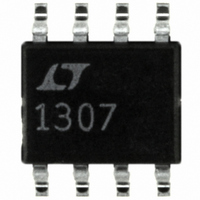LT1307CS8 Linear Technology, LT1307CS8 Datasheet - Page 8

LT1307CS8
Manufacturer Part Number
LT1307CS8
Description
IC DC/DC CONV SINGLE CELL 8-SOIC
Manufacturer
Linear Technology
Type
Step-Up (Boost)r
Datasheet
1.LT1307CS8PBF.pdf
(20 pages)
Specifications of LT1307CS8
Internal Switch(s)
Yes
Synchronous Rectifier
No
Number Of Outputs
1
Voltage - Output
3.3V, 5V
Current - Output
100mA
Frequency - Switching
600kHz
Voltage - Input
1 ~ 5 V
Operating Temperature
-40°C ~ 85°C
Mounting Type
Surface Mount
Package / Case
8-SOIC (3.9mm Width)
Lead Free Status / RoHS Status
Contains lead / RoHS non-compliant
Power - Output
-
Available stocks
Company
Part Number
Manufacturer
Quantity
Price
Part Number:
LT1307CS8
Manufacturer:
LINEAR/凌特
Quantity:
20 000
Part Number:
LT1307CS8#PBF
Manufacturer:
LINEAR/凌特
Quantity:
20 000
Part Number:
LT1307CS8#TR
Manufacturer:
专营LINEAR
Quantity:
20 000
Part Number:
LT1307CS8#TRPBF
Manufacturer:
LINEAR/凌特
Quantity:
20 000
APPLICATIO S I FOR ATIO
LT1307/LT1307B
OPERATION
The LT1307 combines a current mode, fixed frequency
PWM architecture with Burst Mode micropower operation
to maintain high efficiency at light loads. Operation can
best be understood by referring to the block diagram in
Figure 2. Q1 and Q2 form a bandgap reference core whose
loop is closed around the output of the converter. When
V
80mV drop across R5 and R6, forward biases Q1 and Q2’s
base collector junctions to 300mV. Because this is not
enough to saturate either transistor, FB can be at a higher
voltage than V
above 1.22V, causing V
decrease. When V
comparator A1, A1’s output goes low, turning off all
circuitry except the input stage, error amplifier and low-
battery detector. Total current consumption in this state is
50 A. As output loading causes the FB voltage to de-
crease, A1’s output goes high, enabling the rest of the IC.
Switch current is limited to approximately 100mA initially
after A1’s output goes high. If the load is light, the output
voltage (and FB voltage) will increase until A1’s output
goes low, turning off the rest of the LT1307. Low fre-
quency ripple voltage appears at the output. The ripple
frequency is dependent on load current and output capaci-
tance. This Burst Mode operation keeps the output regu-
lated and reduces average current into the IC, resulting in
high efficiency even at load currents of 100 A or less.
If the output load increases sufficiently, A1’s output re-
mains high, resulting in continuous operation. When the
LT1307 is running continuously, peak switch current is
controlled by V
is turned on at the beginning of each switch cycle. When
the summation of a signal representing switch current and
a ramp generator (introduced to avoid subharmonic oscil-
lations at duty factors greater than 50%) exceeds the V
signal, comparator A2 changes state, resetting the flip-
flop and turning off the switch. Output voltage increases as
switch current is increased. The output, attenuated by a
resistor divider, appears at the FB pin, closing the overall
loop. Frequency compensation is provided by an external
series RC network connected between the V
ground. Low-battery detector A4’s open collector output
(LBO) pulls low when the LBI pin voltage drops below
8
IN
is 1V, the feedback voltage of 1.22V, along with an
IN
C
. When there is no load, FB rises slightly
to regulate the output voltage. The switch
C
U
reaches the bias voltage on hysteretic
C
(the error amplifier’s output) to
U
W
U
C
pin and
C
200mV. There is no hysteresis in A4, allowing it to be used
as an amplifier in some applications. The entire device is
disabled when the SHDN pin is brought low. To enable the
converter, SHDN must be at V
The LT1307B differs from the LT1307 in that there is no
hysteresis in comparator A1. Also, the bias point on A1 is
set lower than on the LT1307 so that switching can occur
at inductor current less than 100mA. Because A1 has no
hysteresis, there is no Burst Mode operation at light loads
and the device continues switching at constant frequency.
This results in the absence of low frequency output voltage
ripple at the expense of efficiency.
The difference between the two devices is clearly illus-
trated in Figures 3 and 4. The top two traces in Figure 3
show an LT1307/LT1307B circuit, using the components
indicated in Figure 1, set to a 5V output. Input voltage is
1.25V. Load current is stepped from 1mA to 41mA for both
circuits. Low frequency Burst Mode operation voltage
ripple is observed on Trace A, while none is observed on
TRACE A
TRACE B
TRACE A
TRACE B
Figure 4. At Higher Loading and a 1.5V Supply, LT1307
Again Exhibits Burst Mode Operation Ripple at 5mA Load,
LT1307B Does Not
Figure 3. LT1307 Exhibits Burst Mode Operation Ripple at
1mA Load, LT1307B Does Not
AC COUPLED
AC COUPLED
AC COUPLED
AC COUPLED
200mV/DIV
500mV/DIV
200mV/DIV
500mV/DIV
LT1307B
LT1307B
I
I
LT1307
L
LT1307
L
41mA
45mA
V
V
V
V
5mA
1mA
OUT
OUT
OUT
OUT
V
V
V
V
IN
OUT
IN
OUT
= 1.25V
= 1.5V
= 5V
= 5V
500 s/DIV
IN
1ms/DIV
or at a higher voltage.
1307 F04
1307 F03
1307fa














